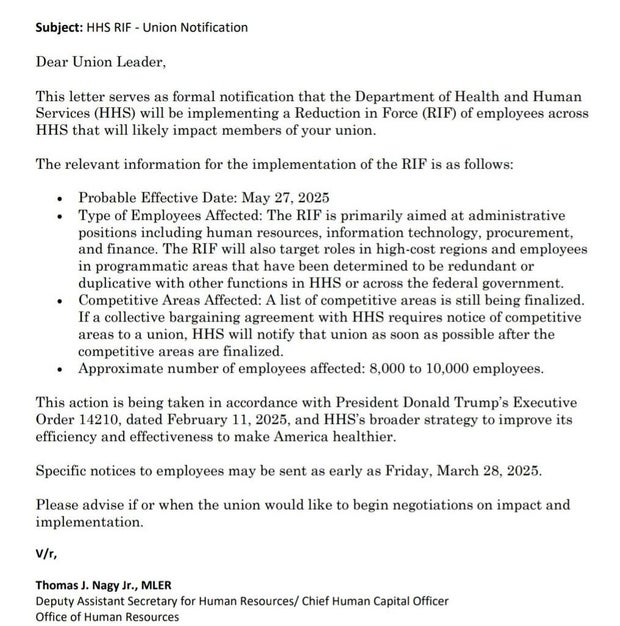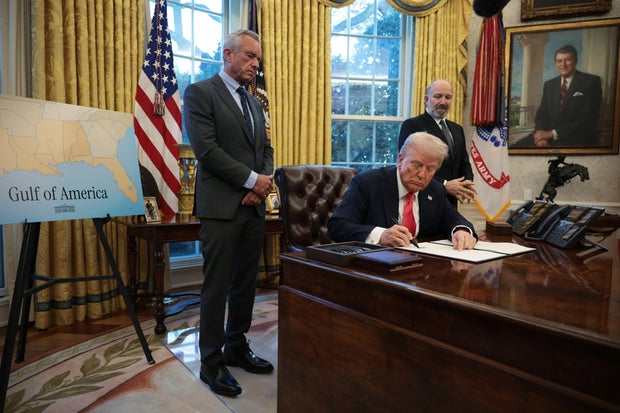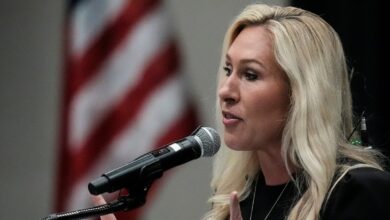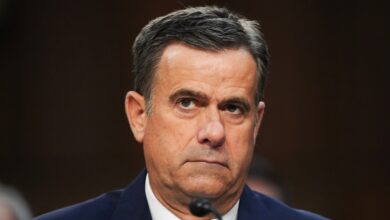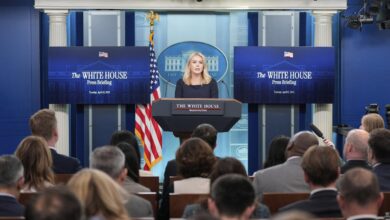Trump administration to shrink federal health agencies by 20,000 employees
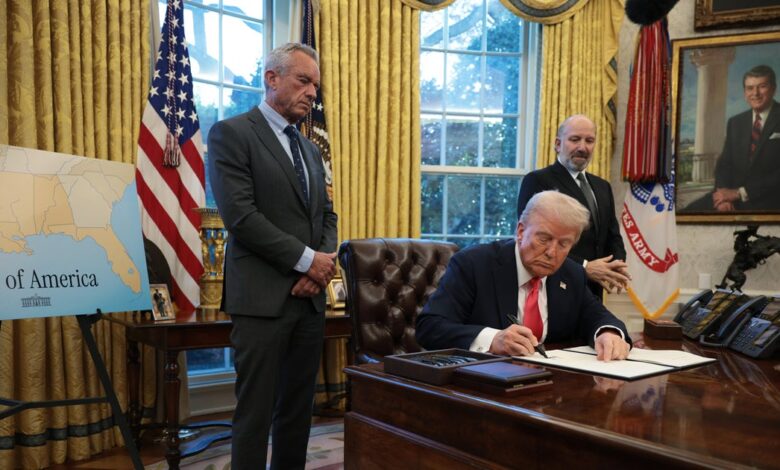
The Trump administration plans to shrink the workforce of the Department of Health and Human Services by nearly a quarter, officials announced Thursday, as part of a major restructuring of the department.
Managers in several health agencies are now racing to figure out details on how the reorganization will impact their work.
Trump officials in multiple parts of the department have said they are aiming to implement much of the changes quickly, often within 10 days.
The changes amount to a workforce that will be around 33% smaller than it was at the end of the Biden administration. There were around 92,620 employees at the department in September 2024, according to federal records, up from 81,917 at the end of the Trump administration.
Some 10,000 full-time employees will be cut through the layoffs, in addition to other vacant positions that will not be replaced. Thousands of full-time staff have already left the department in recent months, in addition to thousands more contractor and fellowship positions that were also eliminated.
“When combined with HHS’ other efforts, including early retirement and Fork in the Road, the restructuring results in a total downsizing from 82,000 to 62,000 full-time employees,” the department said in a release, estimating that taxpayers would save $1.8 billion from the changes.
A fact sheet shared with reporters and health officials says that “no additional cuts are currently planned” beyond those announced Thursday and in recent weeks.
Health and Human Services Secretary Robert F. Kennedy will cut 3,500 jobs from the Food and Drug Administration, according to the fact sheet. The administration is also cutting 1,200 jobs from the National Institutes of Health.
“This reduction will not affect drug, medical device, or food reviewers, nor will it impact inspectors,” the fact sheet says of the FDA changes.
At the CDC, the department says the workforce will decline by around 2,400 employees, to “focus on returning to its core mission of preparing for and respond to epidemics and outbreaks.” One U.S. official said the cuts are not intended to undermine infectious disease work at the agency.
From the Centers for Medicare and Medicaid Services, the workforce will decline by “approximately 300 employees, with a focus on reducing minor duplication” at CMS, which had already been facing hiring limits due to a budget crunch in recent years. The reorganization will not impact Medicare or Medicaid services, it says.
The department’s reduction-in-force “is primarily aimed at administrative positions,” according to a letter sent Thursday to unions in mutliple HHS agencies, but “will also target roles in high-cost regions” and who are “determined to be redundant or duplicative” with others.
“Specific notices to employees may be sent as early as Friday, March 28,” according to the letter, a copy of which was obtained by CBS News.
“The entire federal workforce is downsizing now. So this will be a painful period for HHS,” Kennedy said in video annoncement shared Thursday by the department.
The Wall Street Journal first reported details of the reorganization.
Health officials had been bracing for steep cuts to be announced this week, as part of the sweeping restructuring architected with the White House’s Department of Government Efficiency cost-cutting task force.
Several health agency officials said they had seen stepped up security measures coming into work this morning. Managers have largely been in the dark about the changes, officials have said, aside from a handful of changes already announced within the department.
One major change announced earlier this month would result in significantly cutting the number of general counsel offices, shrinking the ranks of the department’s attorneys. One health official said the closures would amount to eliminating two-thirds of the HHS regional attorneys.
Alex Wong / / Getty Images
Kennedy said earlier this week at the White House that the DOGE team headed by billionaire Elon Musk had “identified extraordinary waste in my department and HHS.” He cited what they considered duplicated work for communications, procurement, IT and HR departments across 40 operating divisions in HHS.
“We are with Elon’s help eliminating the redundancies,” Kennedy said Monday.
One of Kennedy’s biggest proposed changes is to create a new grouping of agencies called the Administration for a Healthy America, or AHA, which he says will save money and “radically improve our quality of service.”
“We’re going to imbue the agency with a clear sense of mission to radically improve the health of Americans and to improve agency morale. We’re going to eliminate an entire alphabet soup of department sand agencies while preserving their core functions,” Kennedy said in the Thursday video.
The new administration will consolidate work from the Office of the Assistant Secretary for Health, Health Resources and Services Administration, Substance Abuse and Mental Health Services Administration, Agency for Toxc Substances and Disease Registry and National Institute for Occupational Safety and Healthy “into a new, unified entity,” the department said.
This new AHA agency also effectively combines many of Kennedy’s “Make America Healthy Again” priorities under one roof, ranging from this year’s update to federal dietary guidelines to public health statements about the use of fluoride. The work will be supported by the U.S. surgeon general, the fact sheet says.
Officials within the Health Resources and Services Administration are expecting deep cuts from the merger, including to the agency’s human resources and Provider Relief Bureau staff, two officials said.
HRSA’s Provider Relief Bureau had been charged with oversight of aid dollars during the COVID-19 pandemic in the health care industry. More than $1 billion in debts to the federal government could go unrecouped if the team’s work is left unfinished, one official said.
“Our budget was already covered with the original funding and would have been recouped five times over, had we been allowed to do our job,” the official said.
The Administration for Strategic Preparedness and Response, which was elevated into a separate agency under the Biden administration to oversee tasks like the pandemic stockpile, will be absorbed into the CDC.
The two agencies are now scrambling to draw up plans by Saturday on how to merge the two, one health official said.
Work from the Agency for Healthcare Research and Quality, which had been bracing for as much as 90% of their staff to be cut by DOGE, will be merged with another agency to create the Office of Strategy.
And the functions from the Administration for Community Living targeted at older adults and people with disabilities will be moved to other agencies, the department said, including the Centers for Medicare and Medicaid Services.
“The entire federal workforce is downsizing now. So this will be a painful period for HHS,” Kennedy acknowledged in his remarks.
Details of who exactly will be cut from the department within the agencies remain unclear, under the new reorganization plans. As of Thursday morning, multiple federal health officials said they had received little guidance from the department, aside from Kennedy’s announcement.
In his remarks in the video, Kennedy said that they were “focused on paring away excess administrators while increasing the number of scientists and frontline health providers” in the changes.
“We’re going to streamline our agency and eliminate redundancies and invite everyone to align behind a simple, bold mission: I want every HHS employee to wake up every morning asking themselves, ‘what can I do to restore American health today,'” he added.

